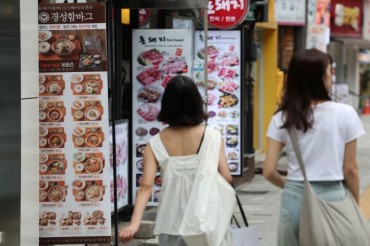
Taiwan-born singer Tzuyu promotes Huawei’s Y6 smartphone in an advertisement (Image : LG Uplus Corp.)
SEOUL, Jan. 15 (Korea Bizwire) – Taiwan-born singer Tzuyu, a member of the popular girl group TWICE under South Korea’s JYP Entertainment, promotes a Huawei smartphone in advertisements that local mobile carrier LG Uplus Corp. has posted on YouTube and other online platforms.
It’s no surprise that a foreigner appears on South Korean ads as South Korea booming entertainment industry has ushered in several overseas-born celebrities. But what’s rather intriguing is that a smartphone, not made by Samsung Electronics Co. or Apple, is plugged into mainstream platforms.
The Huawei Y6, which made its debut in the South Korean market through LG Uplus in mid-December, saw its sales reach 20,000 units this week. The performance of the Y6 smartphone is considered significant as the market did not react this way when Huawei first debuted on the South Korean market at end-2014 with the X3 smartphone.
Huawei is not the only Chinese smartphone maker that is trying to break into South Korea, home to global market leader Samsung Electronics. Huawai’s archrival Xiaomi is poised to make its official debut in the South Korean market soon.
Local online shopping mall Interpark said earlier in January it will commence the sales of a Xiaomi smartphone under cooperation with KT Corp., the country’s No. 2 mobile carrier. Although the plan was held off, apparently due to the watchful eyes of South Korean manufacturers, industry sources expect the Chinese giant will tap into the local market in no time.
Xiaomi’s Redmi Note 3 smartphone has already been a hit among early-adopters since end-2015. Industry watchers estimate around 10,000 units were sold here through direct purchases.
Industry watchers say that shaking off their image as Samsung and Apple knockoff makers, Chinese smartphone companies are increasingly trying to make inroads into South Korea with cheaper, quality devices.
“The design and performance of Chinese smartphones have improved,” said Tom Kang, a researcher at Hong Kong-based market tracker Counterpoint. “Due to their strong cost efficiency, they hold a strong potential in the South Korean market.”
Kang said the Chinese smartphones, which currently take up around 1-2 percent of the local market, may expand its share to reach 5 percent by the end of this year. Samsung and LG still are leading players in South Korea, with their combined market share hovering above 80 percent as of end-June.
“Durability and warranty services are disadvantages (of the Chinese smartphones),” Kang added. “But the South Korean market lacked diversity due to the strong dominance of Samsung and Apple. There are demands (for new types of smartphones.)”
Analysts also say another contributing factor is South Korea’s handset subsidy rule.
In 2014, Seoul implemented a law strictly banning excessive discounts or illegal subsidies to customers, which policymakers said have distorted the local market by allowing mobile carriers to steal each other’s customers.
In addition, the foray of Chinese smartphones into South Korea comes at an opportune time as demand for budget smartphones has been rising fast here in the wake of a prolonged economic slump.
In total smartphone sales, the portion of budget handsets priced 500,000 won and below accounted for 34 percent in the January-October period, up from around 20 percent posted a year earlier, another data report compiled by the ICT ministry showed.
The presence of Chinese smartphone makers in South Korea has spawned an army of loyalists and a number of online communities sharing information on how to purchase and operate China-made smart devices.
“The firmware of Xiaomi smartphones are very convenient, including its elegant design and animation,” a blogger named “Klasses” said in an e-mail interview with Yonhap News Agency. The blogger currently runs a South Korean online community of Xiaomi users with nearly 200,000 members.
“I can say that there are absolutely no hurdles in using (direct-purchased) Xiaomi smartphone in South Korea,” the blogger said. “All you have to do is to insert the SIM card you have been previously using, and reboot three times.”
The blogger, who currently owns six Xiaomi smart devices, claims to have used various smartphones, including those from Samsung Electronics, LG Electronics, Motorola and Pantech.
Some analysts caution that Chinese firms’ inroad into South Korea could affect Samsung and LG.
In 2015, Samsung and LG saw their profitability in the mobile business plunge due to the rise of Chinese firms and increasing demand for affordable smartphones.
In the third quarter, Samsung IT and mobile business posted an operating profit of 2.4 trillion won, down 11 percent from the previous quarter’s 2.7 trillion won. LG’s mobile communications business, which covers smartphones, posted an operating loss of 77.6 billion won in the third quarter, compared with an operating income of 200 million won in the second quarter.
Others, however, say the rise of Chinese players is not an imminent threat to Samsung and LG, but still could have a significant impact if the current system perseveres.
“Most of the South Korean users prefer to pay a few extra bucks to purchase local brands that boast far better features and warranties compared to Chinese brands,” a smartphone dealer surnamed Lee said. “Price is not the only nor the top concern for local users, at least for now.”
“It is true that many users visit our shops to check out Huawei smartphones. But the majority of them eventually turn to buy other models because they are too slow. There are more complaints from the Y6 buyers than those of other models,” Lee added.
“But if the government maintains the regulatory policy, more users may opt for budget options, eventually allowing Chinese firms to expand their shares here,” Lee also said.
The blogger “Klasses” said Chinese smartphones are no match for South Korean models in terms of technology, but it is the government that induces local users to seek budget models made by overseas players.
“Isn’t it natural for users to seek alternatives due to the problematic rules like the smartphone retail law?” the blogger said. “The Chinese smartphones, they are only alternatives. If South Korea were to set more reasonable prices for smartphones, Chinese models would have little chance of making it here.”
(Yonhap)






